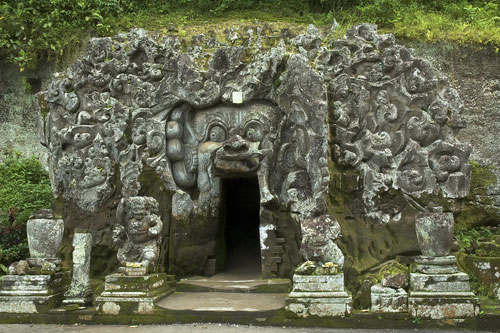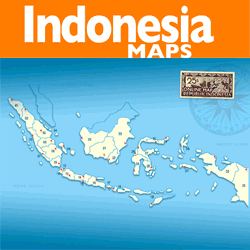Gajah Cave (Goa Gajah)

Goa Gajah, literally means 'Elephant Cave”. Although named by 'elephant' it doesn't mean there is any real elephant live or ever live here. The name Goa Gajah derived from 'Lawa Gajah', which is mentioned in the manuscripts that found in this site. This temple complex was built for the first time around 11 century based on epigraph found in this site.
A seven-meters deep cave with a shape of T-letter is the major attraction of this Bedulu village's local temple. The cave itself is carved in a solid stone hill of the river valley. The main figure of the carving at the cave entrance is 'boma', a barong face, accompanied with big clapping fingers on its side. Leaf, flower, and some horror figures can be noticed if we give more attention look to the rest of the carving. Some holes that are considered to be used as meditation or sleeping quarters can be found in the wall of the cave. Nowadays, those holes are used to place offerings whenever there is ceremonies taking place. On the left end side of the cave is Ganesha statue, believe it as 'the God of knowledge'. Meanwhile on the right end side can be found three 'linggas', that each of them dedicated to the three common God manifestations in Bali, Brahma, Wisnu, and Siwa. There are other three stone carvings in the centre wall, one of them figuring head and face.
Three other statues of Ganesha, demons and Men Brayut, a legendary lady with her beloved children, are placed on a high building located on the left side of cave entrance. It is considered that these statues are 1000 years old. In the middle of the complex, in front of the cave, there is bathing place that is not any longer used by the local people. The angle figures within the bathing complex are about similar to common figures found in India. On the south part of the complex, there are along flight of step leads down the lower part of the valley. After crossing a bridge above a small creek and follow another flight of steps up to eastern side of the valley, a headless sitting Buddha statue can be seen. This is the evident of a close relationship between the two religions.
How to Get There
The Elephant Cave is located just 10 minutes southeast of Ubud in Central Bali, Indonesia. Tours that take in Goa Gajah as well as other surrounding temples and sites can be arranged in Ubud. Alternatively, motorbikes can be rented in Ubud. Having he freedom of transportation to explore the smaller tourist sites surrounding Ubud is a big plus. Begin by driving south of Ubud past the monkey sanctuary toward Bedulu, then turn east (left) onto Jalan Raya Goa Gajah. Numerous signs indicate the way to Goa Gajah as well as other attractions. A trivial fee is charged for parking at the Elephant Cave.
Nearby Tourist Attractions
- Ubud Monkey Forest
- Nyuh Kuning Village
- Pasar Seni Ubud
Accommodations
- Ubud Dedari Villas
- Pancoran Hostel Bedulu
- Petanu River Villa.








